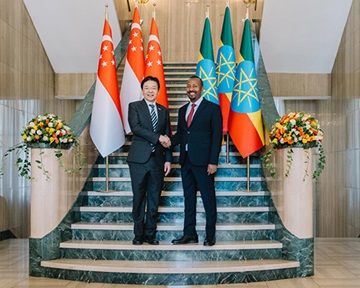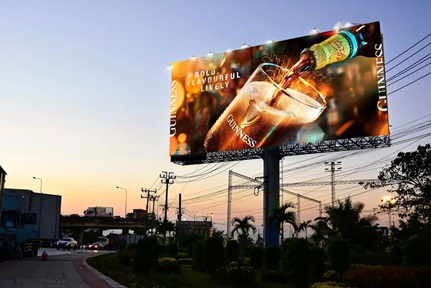Africa finds itself in a position of advantage as the West attempts to blunt China’s influence
Europe and US launch new programmes to counter China’s Belt and Road Initiative
By Johan Burger and Amit Jain

Competition between the West and China over Africa has been building up for decades ever since the Chinese began making their presence felt through trade, investments, and hard infrastructure. After years of expressing concern about Beijing’s increasing influence on the continent the West has finally starting to put the money where the mouth is. In June 2021 the Joe Biden-led US administration announced the Build Back Better World (B3W), a joint Washington and G7 initiative that will collectively catalyse ‘hundreds of billions’ of dollars of infrastructure investment for low- and middle-income countries, which will see Washington mobilise as a counter to China’s Belt and Road Initiative (BRI). Europe followed that with a US$340bn private and public infrastructure investment programme for the developing world – most of which is ostensibly directed towards Africa. As China and the West compete for influence Africa finds itself in a position of advantage.
The B3W vs the BRI
The B3W aims to mobilise US$40trn in investments by 2035. The Biden administration calls it a “values-driven, high-standard, transparent and climate-friendly alternative” to the BRI. It is widely seen as the cornerstone of President Biden’s engagement with the developing world and an answer to China’s BRI.
Some, however, believe that the B3W complements rather than counterbalances the BRI and that the two initiatives have different goals and approaches. The B3W relies on mobilising private sector capital while the BRI is largely financed by loans from Chinese state-owned enterprises. Another difference is that the BRI focuses on hard infrastructures such as roads and dams, while the B3W emphasises soft infrastructure such as climate, health and security, digital technology, and gender equity and equality. The only real overlap is in the ICT sector.
During a visit to Ghana and Senegal in 2021, US Deputy National Security Adviser Daleep Singh identified ten projects for B3W funding – most of which are in the energy and health sectors. Thus far it is unclear whether B3W will also include investments in rail, roads, and ports – something which the BRI has come to be identified with. A formal B3W launch event is reportedly planned for early 2022 and will include more detail about the projects it will be involved in.
The Biden administration’s newfound will to counter BRI follows an attempt made by the previous one. The Trump administration launched Prosper Africa in 2018. The initiative was aimed at boosting USA investment, growing Africa’s middle class, and enhancing business climates across the region. It too was touted as a program to counter Chinese influence in Africa. Prosper Africa helped bring more than 280 deals worth an aggregate US$22bn to financial closure in more than 30 African countries. Projects it supported include infrastructure projects, access to credit, and financial services.
The EU Global Gateway Vs BRI
If the B3W was Washington’s answer to the BRI then Global Gateway is Brussels’ response. Under this plan European members states will invest US$340 billion in public and private infrastructure in the developing world. This includes US$153bn in investment under the European Fund for Sustainable Development plus (EFSD+); US$20.3bn in grants; and US$164bn in planned investments by financial and development finance institutions of individual European members states. The ‘gateway’ will focus on projects in the digital, climate and energy, transport, health, education, and research sectors. It also intends to share European technology and expertise with developing economies.
EU Commissioner for International Partnerships Jutta Urpilainen claims that the size of European aid between 2013 and 2018 was about the same as the funding under BRI. According to UNCTAD and the American Enterprise Institute, the EU and EU countries provided around US$396bn in Official Development Assistance (ODA) grant equivalent between 2014 and 2018. This compares favourably with the BRI loans of between US$226bn and US$452bn. Europe’ contribution can be seen as more significant as grants represent a much bigger financial contribution than a loan.
However, the EU’s approach has been said to be fragmented into numerous initiatives, undertaken at both EU and national levels. The Global Gateway is seen as an important step in the consolidation process of Europe’s development finance as it focuses on the strategic issue of infrastructure development and connectivity.
To support the Global Gateway plan, the EU is looking at creating a European Export Credit Facility, which will ‘complement’ existing credit arrangements by individual EU member states.
Some believe that the Global Gateway provides a better alternative for infrastructure development as it focuses on limiting risks of debt distress in partner countries. This is in contrast to the BRI which provides loans that the borrower countries frequently cannot afford. EU grants, like the USAID, often come with a lot of strings attached. Recepient countries have to adhere to the rule of law, human rights as well as demonstrate ‘respect’ for intellectual property that often gives Western companies exceptional competitive advantage in markets that are often very price sensitive. Chinese loans, however, come with fewer such requirements making them much more attractive to governments whose human rights record after fall short of Western expectations.
Others Vs BRI
India and Japan launched the Asia-Africa Growth Corridor (AAGC) in 2017 as a joint effort to counter BRI. It has been touted as a ‘smarter’ approach to development finance aimed at addressing connectivity, skills development and capacity building and institution building. Regarding connectivity, it emphasizes quality infrastructure, which is aligned with Japan’s infrastructure export policy adopted in 2015. Although these are early days and it is difficulty to evaluate the impact AAGC will have on Africa, the exceptionally slow and cautious approach taken by the two countries and the lack of political conviction behind it means that it is very unlikely to be much of a competition to the BRI. Indeed, in the early days of the AAGC, it was also suggested that it was unnecessary for the AAGC and BRI to compete as they could complement each other, with Africa being the primary beneficiary.
Conclusion
China currently dominates in Africa’s hard infrastructure investment, such as dams and railways, which are areas in which companies from the USA and Europe have been hesitant to invest in.
The West sees the BRI as a tool for China to win influence with developing countries by ‘trapping’ governments with too much debt. Western critics say the confidentiality clause in the BRI tender process undermines transparency and is prone to corruption. China denies these allegations, claiming that it respects its partners' sovereignty while African officials are often rankled by the refusal of Western critics to give African government the respect and ‘agency’ in guarding their own interests.
Debt, however, remains a sensitive issue. In Africa’s case debt distress has become so acute that Chinese banks have started to demand feasibility studies before approving loans. A good example is the rail extension project from Naivasha in Kenya to Kampala in Uganda that the Chinese have declined to finance.
The main differentiating factor between the US approach and the BRI is the financing model for big infrastructure projects such as ports and power dams. In 2018, US engineering and construction firm Bechtel Corporation proposed to build a highway from Nairobi to Mombasa. While Kenya proposed that Bechtel recover its investment through tolls, Bechtel preferred the Kenyan government to directly fund the construction. In contrast, the PPP model that has most successfully been carried out in Africa is the one adopted by China. One example is the 27.1km highway linking the airport in Nairobi with central Nairobi. The China Road and Bridge Corporation (CRBC) will recoup its US$668m investment by charging toll fees for 27 years.
Tim Zajontz from Stellenbosch University’s Centre for International and Comparative Politics in South Africa believes Western firms will struggle to beat Chinese firms in Africa on price. Chinese engineering firms are very cost-competitive. They also come with a stellar track record of completing projects in time. Western firms have lost that edge over time. The poor fiscal situation of many African governments require grants and guarantees to mobilise private sector investment. Despite all is flaws the BRI remains attractive.
At the FOCAC summit held in Senegal on 29 November 2021, Chinese President Xi Jinping outlined nine initiatives China intended to implement over the next three years, focusing mostly on providing coronavirus vaccines (1bn vaccines), growing trade, and encouraging Chinese private sector investment in Africa. He pledged US$30bn in trade finance and credit facility and promised to share US$10bn of its recently-received IMF special drawing rights (SDR) of US$29.2bn with African countries. Other commitments include opening “green lanes” for African agricultural exports to China, simplifying inspection and quarantine procedures, and widening market access to African exports by lifting tariff on more product lines. China’s target is for total imports from Africa to reach US$300 billion in the next three years.
The nature and size of the commitments made during the 2021 FOCAC contrasts with previous summits where huge financial packages were announced with Chinese policy banks lending billions of dollars for infrastructure development. In both the FOCAC meetings of 2015 and 2018, Xi pledged US$60bn to finance Africa’s infrastructure under the BRI, in the process funding the construction of highways, railways, and power plants across Africa. The recent FOCAC signals a change in direction.
Africa is in a unique position to exercise agency in its dealings with China as well as the West. It can use it to plug critical gaps in both hard and soft infrastructure and in doing lay a stronger foundation for a more stable, stronger and prosperous future.
Additional readings:
Anon. 2021. Build back better world (B3W) and the Belt and Road Initiative (BRI): prospects and limitations – 27 October 2021. King’s College London: King’s Events. 27 October 2021. Available at https://www.kcl.ac.uk/events/build-back-better-world-b3w-and-the-belt-and-road-initiative-bri-prospects-and-limitations. Accessed 20 November 2021.
Anon. 2019. Declaration of the First Russia-Africa Summit. Summit Economic Forum Russia-Africa. 24 October 2019. Available at https://summitafrica.ru/en/about-summit/declaration/. Accessed 8 December 2021.
CSR. 2020. The Trump Administration’s Prosper Africa Initiative. Congressional Research Service. 17 November 2020. Available at https://sgp.fas.org/crs/row/IF11384.pdf. Accessed 20 November 2021.
Fox, B. 2021. Turkey’s Erdogan puts Europe’s colonial past at heart of pivot to Africa. Euractiv. 21 October 2021. Available at https://www.euractiv.com/section/global-europe/news/turkeys-erdogan-puts-europes-colonial-past-at-heart-of-pivot-to-africa/. Accessed 8 December 2021.
Kedem, A. 2021. Erdogan pledges to double bilateral trade at Turkey-Africa business forum. African Business. 19 October 2021 (sic). Available at https://african.business/2021/10/trade-investment/erdogan-eyes-deals-at-turkey-africa-summit/. Accessed 8 December 2021.
Nyabiage, J. 2021. Xi Jinping plays up roles for private sector in China-Africa trade and finance. South China Morning Post. 1 December 2021. Available at https://www.scmp.com/news/china/diplomacy/article/3157912/xi-jinping-plays-roles-private-sector-china-africa-trade-and. Accessed 8 December 2021.
Nyabiage, J. 2021. Room in Africa for both China’s belt and road plan and Biden’s B3W. South China Morning Post. 15 November 2021. Available at https://www.scmp.com/news/china/diplomacy/article/3155857/room-africa-both-chinas-belt-and-road-plan-and-bidens-b3w. Accessed 20 November 2021.
Prime Minister’s Office. 2021. PM launches new initiative to take Green Industrial Revolution global. Gov.UK. 1 November 2021. Available at https://www.gov.uk/government/news/pm-launches-new-initiative-to-take-green-industrial-revolution-global. Accessed 8 December 2021.
Reuters. 2021. G7 leaders adopt ‘Build Back better World’ plan to rival China’s belt and road strategy. South China Morning Post. 12 June 2021. Available at https://www.scmp.com/news/world/europe/article/3137097/g7-leaders-adopt-build-back-better-world-plan-rival-chinas-belt?module=inline&pgtype=article. Accessed 20 November 2021.
Tagliapietra, S. 2021. The Global Gateway: a real step towards a stronger Europe in the world? Bruegel Blog. 7 December 2021. Available at https://www.bruegel.org/2021/12/the-global-gateway-a-real-step-towards-a-stronger-europe-in-the-world/. Accessed 8 December 2021.
Taniguchi, T. 2020. Should we forget about the Asia-Africa Growth Corridor? Lettre du Centre Asie, No. 87, October 19, 2020. Available at https://www.ifri.org/en/publications/editoriaux-de-lifri/lettre-centre-asie/should-we-forget-about-asia-africa-growth. Accessed 20 November 2021.








